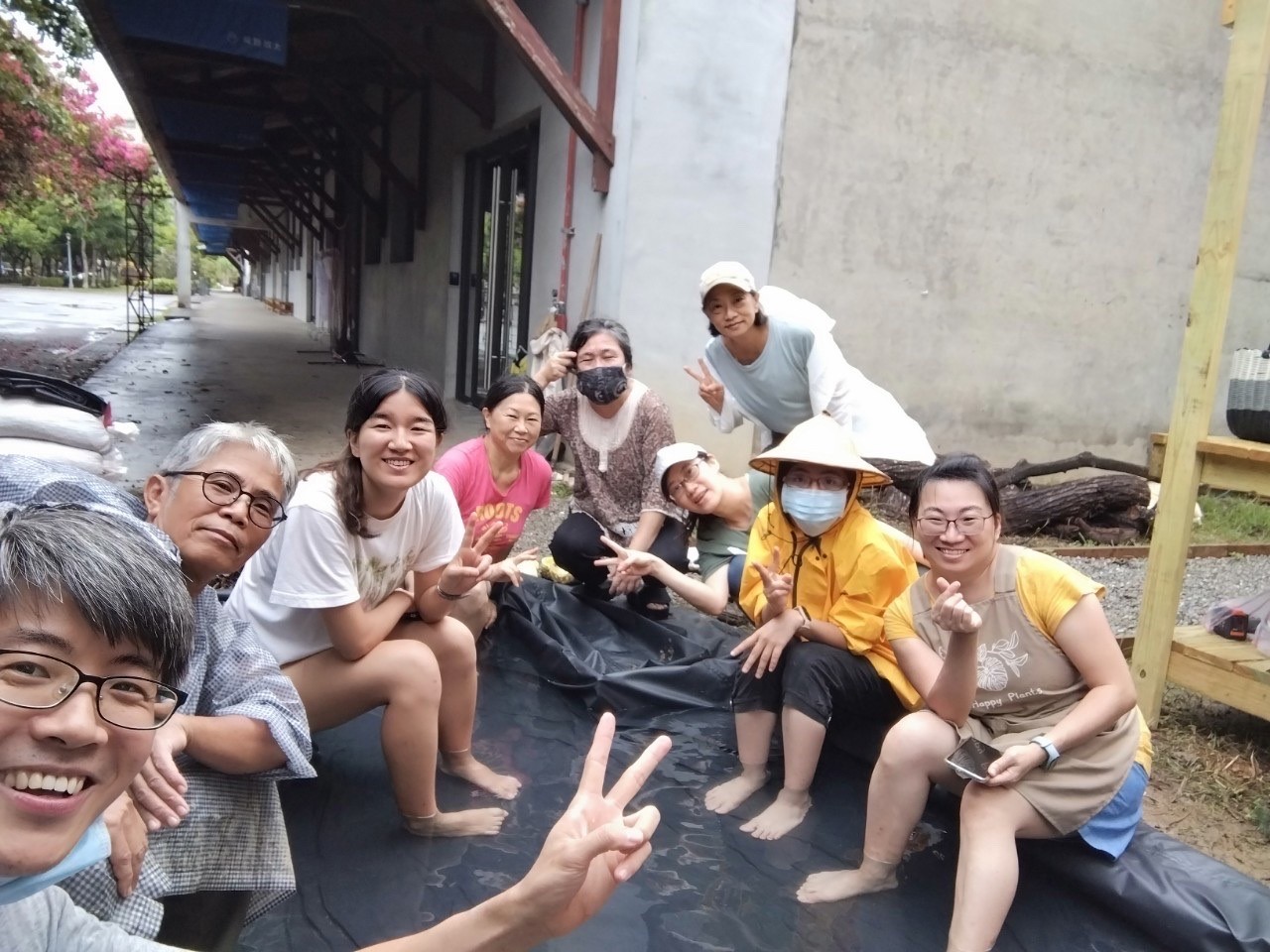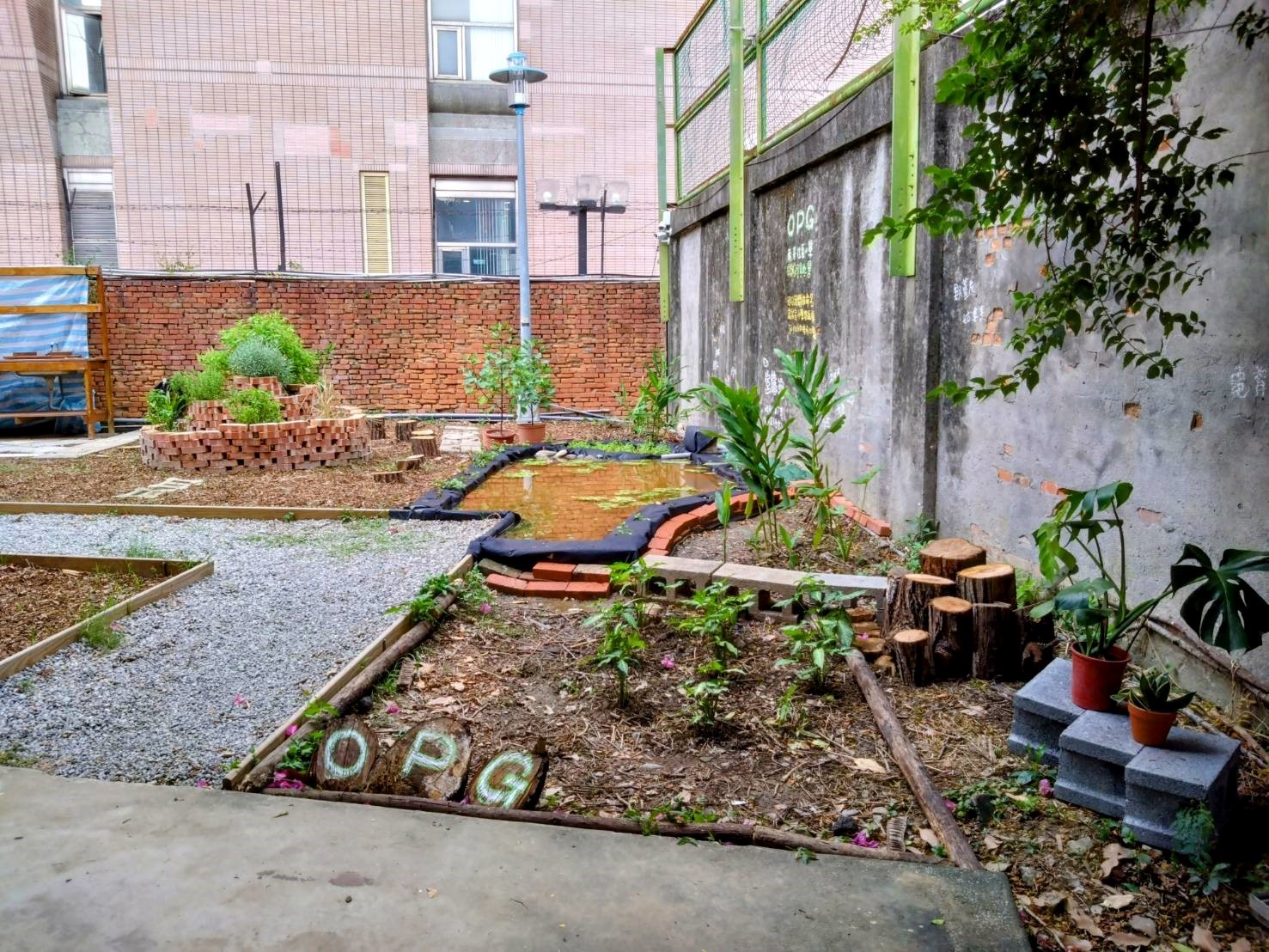
文/National Taiwan University Global Health Program Stephanie Zhang
On land, Yangmingshan soil is meat floss. In water, Yangmingshan soil is Thai tea.
This past summer, every time I ripped open bags of the soil, poured it onto tarps, let it run through my fingers, I found myself thinking of various ochre-toned foods. On land, Yangmingshan soil mixed with other types of soil for an edible herb garden, and in water, Yangmingshan soil settled to the bottom of an ecological pond just a few steps away. Both of these projects were carried out through the NGO Wanhua School’s (萬華社區小學) collaboration with Open Green (打開綠生活; OPG), a funding program that promotes urban regeneration, community engagement, and city-nature connections. Wanhua School is dedicated to educating the public about Wanhua and empowering Wanhua through community building.
Although I had already been to Wanhua District a couple of times, it was Wanhua School’s tour that truly brought me inside the district. The Global Health Program’s required course Social and Behavioral Foundations of Health and Health Care designated this tour of Wanhua as the semester’s field trip. In preparation, Professor Shu-sen Chang informed our class that Wanhua was one of the most deprived areas in Taipei. I was shocked—how could Taipei’s oldest region, rich with history and culture, simultaneously be so impoverished and stigmatized? After all, Wanhua—or Bangka as it used to be called, named after the Taiwanese Indigenous people’s boats—was the very city that ushered in Taipei’s commercial prosperity. With its advantageous trading location at the intersection of Dahan River, Tamsui River, and Xindian River, Wanhua anchored the city’s economic stability, even in the most literal sense of the verb.
Yet, Wanhua’s story is a reminder that regions are always in flux: development moved eastward in Taipei, putting a premature end to the meaning of its name 萬華: prosperous for ten thousand years. Wanhua School’s Ziyi took us on a walking tour of the region, compassionately shining light on its present-day realities in a way only a Wanhua native educated in social work could. We saw for ourselves just how embedded Ziyi is in the community: as we walked through Bangka Park, one of the main gathering areas for the unhoused population in Taipei, she waved and interacted with some of them. Ziyi informed us that the individuals we saw that day were just a subset of the unhoused community; since it was the daytime, most were away, working. The unhoused population is mostly comprised of 40–50-year-olds who work part-time/temporary jobs during the day, fighting to contribute to society during one of the potentially greatest hardships of their lives. For the entirety of the tour, Ziyi helped to dispel misconceptions that belittle and alienate Wanhua from the rest of Taipei.
From stop to stop, Ziyi threaded histories from both long ago and the recent past with what we saw in the present—and with what the community envisioned for its future. Bopiliao, for example, was designated during the Japanese colonial period for use by the neighboring Laosong Elementary School, a policy which continued even with the ROC’s rule, preserving the architectural juxtaposition of Chinese Qing dynasty and Japanese, Western-influenced styles that we marvel at today. Bopiliao was also the first place to have COVID-19 testing in Taipei, a fact overshadowed by stigma and antagonism toward Wanhua for being a COVID-19 hotspot in the early days of the pandemic. Longshan Temple is famous across all of Taiwan, not only perennially important as a religious and spiritual hub for worries and wishes of all kinds but also once a haven for political activists during the White Terror Period. In all of its functions, Longshan Temple consistently remains an axis around which community is formed and maintained. The Zhonghua Shopping Mall was once the largest public comprehensive mall in the Taipei-Keelung metropolitan area before it was demolished; now, rebuilding discussions are occurring to create a new future for it. Our tour finished in Wanhua School’s office, located in Tangbu Cultural Park, which is similarly built upon the land’s past significance.
Where the Taipei Sugar Refinery used to sit during the Japanese occupation period, the Tangbu Cultural Park now resides. The Tangbu Cultural Park not only preserves Taiwan’s sugar industry history with a sugarcane museum and sugar train but also furthers community and cultural development with performing arts training and rehearsal venues, office spaces, and now… a community garden and ecological pond! Although the Tangbu Cultural Park might seem like a natural consequence of the land’s unique history, we cannot take it for granted: residents campaigned for years to overturn plans for a proposed sanitorium in its place.
Months after the tour, a Taiwanese family friend (阿姨)’s passing comment helped me see for myself what prevailing perceptions of Wanhua are like. As if she were looking out for me, she told me to stay away from Wanhua, “It’s not a good place… A lot of homeless there.” Ironically, by giving me a taste of what exactly Wanhua School was fighting against, her warning compelled me to do the very opposite. I needed to get closer to Wanhua and Wanhua School.
I dove into Wanhua School and OPG’s edible garden efforts, made possible by Chen Yi-Ming (陳一銘), who possesses a wealth of knowledge around forestry, ecology, and outdoors projects. Throughout the summer, we volunteers weeded, poured, planted, pruned, and more, transforming the unsightly stretch of dirt and rocks behind the warehouse housing all the offices, including Wanhua School’s, into a flourishing space fit for the Wanhua community to gather around, take from, and grow with. The herbs and grasses planted were representative of not only Taiwan (e.g., 台灣水蕨) but also Southeast Asia, celebrating the diversity of the Wanhua community today with increasing numbers of migrant workers.
The day of the ecological pond workday, seven other women and I showed up even under threat of a typhoon to realize Wanhua School and OPG’s vision. From 9am to 5pm, we were at work, with our rest breaks dictated by when the rain would start up again. As soon as it would start to pour, we ducked under for cover, running back out to continue building every time it lightened up. Against all odds, defying not only the typhoon but even Yi-Ming’s expectations that we lacked enough manpower, we brought the ecological pond to fruition through collective energy and determination.
It was also this collective energy that attracted local passersby to the site that same day. Before our pond was even finished, it was already doing its job of serving as a space for community connection. In some cases, these conversations gave way to criticisms around planting methods; in other cases, they resulted in being able to borrow a resident’s roselle plants to further beautify the space. Regardless, criticism or compliment, it was so encouraging to see community members huddled around our pond, constructed in the shape of Taiwan, firing Taiwanese Hokkien at one another and with Wanhua School and OPG staff. Hearing all the Taiwanese being spoken, I felt utterly clueless as to what was being discussed, but I was glad to be able to help the community connect on their own terms.
Our efforts have even facilitated gatherings in ways I did not imagine. As revealed by security camera footage, our pond is an oasis for birds who fly in to bathe. As silly as the Yangmingshan and Thai tea analogy is, too, it speaks to our hopes for the pond as a gathering space for Taiwanese and Southeast Asian residents alike. Wanhua School recently hosted a welcome event for Wanhua’s Southeast Asian residents (新南鄉生活節), where attendees were also invited to view the garden and ecological pond area.
Thanks to Wanhua’s thriving NGO efforts, Wanhua District is not going anywhere. Despite people’s views that Wanhua’s days of prosperity are behind it, what if we defined prosperity differently? Wanhua lives on in its people—and even in its plants, fish, and birds. Besides, in Taiwanese, residents still refer to Wanhua using its previous name, Bangka, illustrating the continuity in the Wanhua of today and the Wanhua of back in the day. From this perspective, Wanhua is indeed “prosperous for ten thousand years,” just as it always has been.
I am so grateful to the course Social and Behavioral Foundations of Health and Health Care for bringing me into Wanhua. There is no feeling like knowing a community well enough to be able to join in on existing local efforts. How else could I have ended up crossing paths with such hardworking, bubbly Taiwanese people and creating an ecological pond that, due to the topology of the land available, fortuitously ended up in the shape of Taiwan? As we sat around the edge of the pond soaking our feet, we joked about our positions relative to geography of Taiwan: “I’m in Pingtung!” “I’m in Chiayi!”

figure 1. Ecological Pond

figure 2. Group photo

figure 3. Zoomed Out

figure 4. Soil
